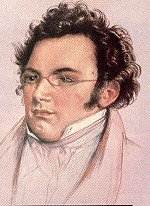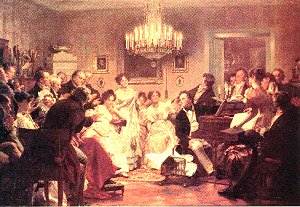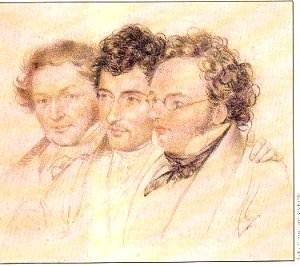The text of a Pre-Concert Talk given at the Hawth, Crawley on Sunday January
16th 2000 by Ian Lace with a review of the recordings used as illustrations.
Although it is indicated in this article where recorded illustrations
were used in that talk it is not our policy to put sound clips on this
site because of copyright and performing rights restrictions.
This file contains:
A transcription of the pre-concert talk
A short recommended reading list.
Reviews of the recordings
The Pre-Concert Talk

Among the greatest 19th Century composers, Franz Schubert is the only one
whose lifetime fame was significantly at odds with his later glory. His shyness
and disregard for self-promotion, his lack of virtuosity as a performer,
the scarcity of his own letters and writings, his untimely death - all these
factors, and more, help to explain why he eluded biographers and why a full
appreciation of his music was delayed for so long after his death. Slowly
through the 19th century, and significantly in the 20th century, his immense
output began to be fully appreciated. Pre-eminent in this process was Otto
Eric Deutsch who worked in Vienna and wrote significant books on Schubert
in 1904 and 1914. But Deutsch's major work for Schubert was in cataloguing
his works and giving them the D numbers we recognise today.
Let us pause at this point to consider the importance for Vienna as the centre
of European music during Schubert's lifetime and before - and, for a considerable
period after his death. Vienna was the centre of the huge and powerful Hapsburg
empire; it is therefore not surprising that composers were drawn by its cultural
allure to seek patronage, to secure commissions and, of course, to promote
performances of their music.
You will recall that the Baroque period in music was from about 1600 to 1759
and included the music of Bach and Handel. If we consider the classical period
that followed, then that includes the works of Gluck, Haydn, Mozart and Beethoven
- all of whom were drawn to Vienna.
Gluck first went to Vienna in 1735, and was appointed opera Kapellmeister
to the Court Theatre in 1854. Gluck lived in Vienna in high style but died
in 1787 defying his doctor by drinking a post-prandial liqueur.
Haydn lived from 1732 to 1809. He arrived in Vienna as an 8 year-old choirboy
but much of his career was spent in Hungary (30 years) and elsewhere in Europe
(he was particularly lionised in England). In the early 1780s, he befriended
Mozart and from then on their works betray a mutual influence. In 1791 Haydn
settled in Vienna and accepted Beethoven as a pupil - not surprisingly, given
Beethoven's volatile temperament, it was an uneasy relationship.
Mozart was born in Salzburg in 1756 and visited Vienna as a 6 year-old child
prodigy in 1762. After many visits to the capital, and disagreements with
his patron in Salzburg, Mozart settled in Vienna after marrying Constanze
Weber in August 1782. The last nine years of his life in Vienna were a mix
of financial troubles and an outpouring of masterpieces in almost every genre.
He died in the City in 1791.
Two years earlier in July 1789, the Bastille was stormed in Paris signalling
the Revolution and afterwards, the rise of Napoleon from whom Austria suffered
a particularly ignominious defeat at Austerlitz. As a consequence, by the
1820s, Vienna was a dangerous place to live, so much so that its citizens
looked back with nostalgia to the golden days of the reign of Joseph II from
1780 to 1790 and delighted in revivals of Mozart's The Magic Flute.
Vienna had grown tremendously for agricultural mechanisation had forced peasants
into the towns and Vienna's population was burgeoning. However, there was
severe overcrowding with little space between houses and the sanitation was
appalling. Schubert was one of 14 children, many of whom never survived to
adulthood and the fact that he died at the early age of 31 was not at all
unusual. Added to all these hazards, was an oppressive regime - there was
heavy censorship and spies everywhere. The ever-present threat of further
revolution all over the Empire caused paranoia amongst the establishment,
from the Emperor and Metternich downwards. Schubert himself was once arrested.
Yet despite all this gloom, there was a growing articulate professional class
hungry for music and literature.
The other musical giant who lived and worked in Vienna was of course Beethoven.
He moved to the City from Bonn in 1795. Beethoven lived from 1770 to 1827
and was therefore practically contemporaneous with Schubert who died the
year after Beethoven in 1828. Schubert was actually a torch-bearer at Beethoven's
funeral. Not surprisingly, during their lifetimes, Beethoven overshadowed
his contemporary. Beethoven's music was very bold and assertive whereas that
of Schubert tended to be more refined and subtle.
Unlike Gluck, Haydn, Mozart and Beethoven, Schubert was a local boy, born
in Vienna, the son of an impoverished schoolmaster, who was his first teacher.
He became a pupil of Salieri (yes, the same Salieri associated with Mozart)
for theory in 1812.

Schubert earned his fame through his songs and dances, and smaller pieces.
He first came to prominence in 1814 with one of his two greatest songs,
Gretchen am Spinnrade a setting of Goethe's poem. In 1815, Schubert
composed 144 songs including 8 in one day. He would scribble them on the
backs of menus in the Viennese coffee houses that he frequented with his
ever-widening circle of friends. It was they who were mainly responsible
for promoting his music. From 1821 we have the first account of the Schubertiades
where Schubert played and sang and a lot of punch was drunk. Such gatherings,
dedicated to high art and high spirits were to be a feature of the next few
years as Schubert's reputation spread and his circle of acquaintances was
enlarged. It was in 1821, too, that his other great song masterpiece,
Erlkõnig was the first to be published. But we will leave the songs
there for a moment and pause for some music.
We move forward to 1823. We now turn the telescope the other way round for
a while to concentrate on that fateful year. It was a year when ill-health
began to trouble Schubert, the beginnings of the syphilis that would take
him to the grave. But it was also the year he composed one of his greatest
song cycles Die schöne Müllerin and the incidental
music for Rosamunde, the Overture to which we are to hear tonight.
Let's just remind ourselves of three or four of the lovely melodies from
the Overture and note their lyricism. Also note that all Schubert's music
even the happiest has a tinge of sadness
Excerpt 1 Three short thematic excerpts from Schubert's Overture:
Rosamunde.
Music from the Overture to Rosamunde played on that recording by the
Vienna Philharmonic Orchestra conducted by Rudolf Kempe. Schubert was dogged
with ill luck when it came to his operas and works for the stage they all
failed - even the Rosamunde music at first; not surprisingly, the
play itself was rather abysmal.
Schubert's output was huge but like many other composers before him and after,
he often eased his load by self-quotation in other works - and he did not
hesitate to quarry from his Rosamunde music. One of his songs, Der
Vollmond Strahlt, written that same year, 1823, borrows from
Rosamunde. Its words begin, 'The full moon beams on the mountain tops:
How I have missed you.' It is a gentle love song - part nocturne, part lullaby.
There is an engaging touch of naïvety about its gently rocking rhythms
and a conscious pastoral evocation. In the play Princess Rosamunde has been
brought up as a shepherdess (through some fancy of her father's) and in the
middle of some protracted melodrama involving her regaining her throne, she
escapes to Axa, her old protector, who sings her this song.
Excerpt 2 Arleen Auger singing Der Vollmond Strahlt accompanied by
Graham Johnson on the Hyperion Schubert Edition Vol 9

Roughly 630 of Schubert's songs survive. By the end of 1828, nearly 190 were
published and many others circulated in hand-written copies. Schubert and
his friends proved remarkably astute in choosing which ones to disseminate,
perform and publish. Interestingly, the songs that were available and best
known to his contemporaries, generally remain the most prominent today.
With Schubert, Romantic Lied gained stature. Along with a heightened literary
awareness, came the Romantic cultivation of small-scale forms in general,
the rise of middle-class musical culture and domestic music making, and the
new tonal qualities and technical capacities of the piano. Accompaniments
of a new intensity and dramatic power were now possible. Schubert was also
adding something new to the Lied. He had a penchant for extreme harmonic
contrast. He included sudden, seemingly unprepared modulations and unexpected
relationships signalling shifts in mood. As Christopher H. Gibbs comments
in his introduction to The Cambridge Companion to Schubert, Schubert was
reinventing the form of the song in order to expand its communicative vocabulary.
Another segment of the Rosamunde incidental music is the lovely song
that is heard in Entr'Act No. 3 in B flat major. This was further used by
Schubert in his A minor String Quartet of 1824. First let's hear the melody
from Rosamunde and then something of the way Schubert uses this material
in the Andante of the String Quartet. Notice, there, how disturbingly, this
happy and innocent melody is transformed in an ensuing contrapuntal furore.
Excerpts - 3) Entr'Act No 3 in B flat major (Rosamunde); the Vienna
Philharmonic Orchestra conducted by Rudolf Kempe.
4) Andante from Schubert's String Quartet in A minor played by the Brandis
Quartett on a 3CD Nimbus set devoted to Schubert's 'Late Chamber Music for
Strings'.
Now let's briefly consider Schubert's orchestral accomplishments. As we know
he wrote nine symphonies, if we include what was referred to as No. 7 in
E major composed in 1821 but left unscored. [But see the comments about
re-numbering in the Harnoncourt Complete Schubert Symphonies set in the Reviews
section below.] The most celebrated of these symphonies are, of course, the
'Unfinished' and the 'Great' C Major. Schubert's first six symphonies were
composed between 1813 and 1818. It is a sad comment on the indifference of
the nineteenth century to Schubert's orchestral works that none of these
early symphonies were published until the 1880s and that it was not until
this century that they were able to command a regular place in the repertory.
Until 1816, Schubert was content to work within the limits of the classical
language and (songs apart) with classical forms. His Symphony No. 5, composed
in 1815 bears in every bar the stamp of his own lyrical genius while the
spirit of Mozart breathes benignly over it. It is the sunniest of all Schubert's
symphonies. Let's hear a little of the opening movement.
Excerpt 5 - First Movement of Symphony No. 5 in B flat
Sir Thomas Beecham, a great champion of Schubert, conducting the Royal
Philharmonic Orchestra in that performance of Schubert's Symphony No. 5 in
B flat.
After 1818, Schubert's work shows a new philosophical depth, and recognisably
romantic themes - all very evident in the Unfinished and Great C Major
symphonies. But let's remind ourselves of the distinction between the classical
and romantic styles in music.
The classical music of Mozart and Haydn, for instance, was absolute - that
is without a programme unlike Beethoven's 'Pastoral' Symphony of 1812 that
was a sound picture of happenings in the countryside. The 'Pastoral' Symphony
was generally regarded as marking the beginning of the Romantic movement.
But the truth is the boundaries were blurred, not so clear cut. Composers
had, for some considerable time, been using the inspiration of stories, pictures,
poems etc to help them write their chamber, instrumental and symphonic writings
- but they never admitted it.
.jpg)
Now, for his Unfinished Symphony Schubert had very definite images in mind
and very disturbing they were too. When Schubert was about 15 years old his
father repeatedly forbade him to compose and when this was to no avail, he
drove him away (Schubert was a boarder at the Imperial Choir School). He
was thus deprived of a last opportunity to see his mother who fell ill and
died during his banishment. This experience was exceedingly traumatic and
caused Schubert allegorical dreams or nightmares that were played out in
his Unfinished Symphony. Schubert has given us the detail of these dreams.
In broad outline, he relates how his father had led him to a feast and commanded
him to enjoy it. When Schubert was unable to do so, his father became angry
and drove him away. Schubert had to wonder for a long time in distant lands
to return only for his mother's funeral. "For many years, I felt immense
grief and pain, and immense love, tear me apart", he said. The dream recurred
except that Schubert was invited into a beautiful garden instead of to a
feast. Again he could not enjoy it and once more he was outcast. In another
part of his dream he heard of the death of a gentle maiden. Reaching her
grave he noticed a ring of mourners around it but he was forbidden to join
them unless a miracle occurred. Suddenly 'the gravestone seemed to send forth
heavenly thoughts like fine sparks upon the youth, producing a gentle sound.
He walked to the graveside and was admitted into the company and felt eternal
bliss. He was also reconciled with his father. The two movements of the symphony
correspond to the two parts of this dream narrative
In the first movement, we can plainly hear the anger of his father and the
affection Schubert felt for his family. This music leaves behind the decorative
sound world of Mozart. In this dramatic excerpt there is much more of the
granite quality we would associate with Beethoven
Excerpt 6 Schubert's Unfinished Symphony played by the Wiener Symphoniker
conducted by Nikolaus Harnoncourt.
Part of the first movement of Schubert's Unfinished Symphony written in 1822,
the year before Rosamunde. Schubert wrote the two movements plus 130
bars of a scherzo, then he abandoned the work because he realised the scherzo
was unnecessary and the work was complete in its two movements - in reality
two parts. It was finished. It only got its reputation as being unfinished
because people were expecting the usual four symphonic movements. So Schubert
was really ahead of his time. Nobody today would worry if a composer turned
in a two-movement work.
After Schubert, Vienna continued to draw composers and musicians throughout
the 19th Century and into the 20th. Brahms, the waltz Strauss, Bruckner,
Mahler, Richard Strauss, the atonal progressives such as Schoenberg and the
traditionalists like Korngold. The latter two had to flee Vienna when the
Nazis arrived. Their predicament and World War II pretty well sounded the
death knell of the City as a major force in music.
But Schubert today ranks among the very greatest of composers in all forms
except operas and concertos (of which he wrote none).
*********************************************************************
Recommended Reading:
The Cambridge Companion to Schubert - a series of essays edited
by Christopher H. Gibbs. 340 pp. Cambridge University Press 1997 (Available
in paperback).
Amazon
UK £13.77
Amazon
US $21.95
Schubert by John Reed - in The Master Musicians Series. 320
pp. Westbridge Books. 1987.
Amazon
UK £21.95
Amazon
US $35
Schubert's Songs by Richard Capell 292 pp Gerald Duckworth
& Co. Ltd (first published in 1928)
Out of Print
**********************************************************************
The Recordings with Reviews:
